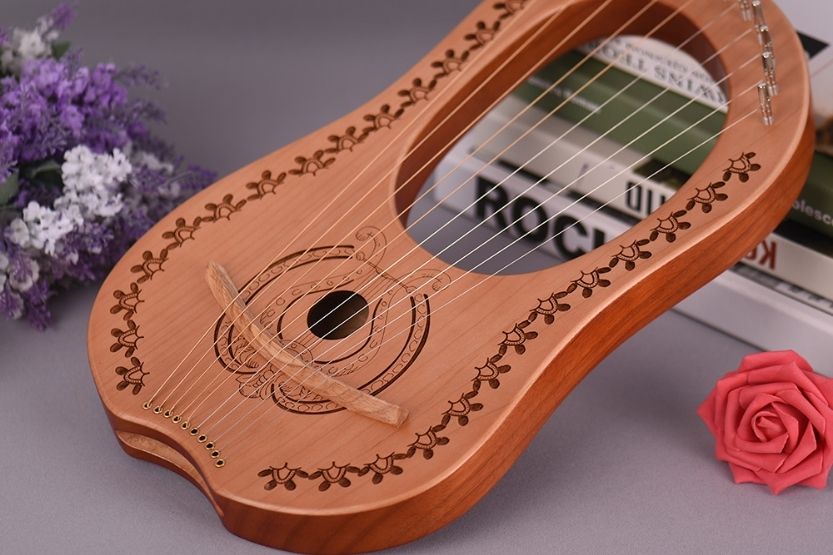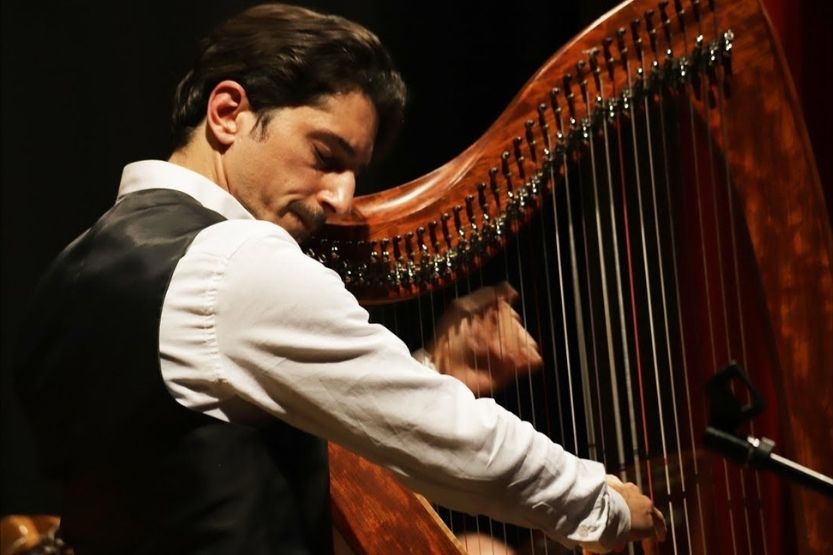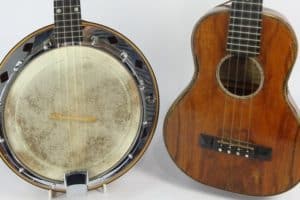The harp is a unique, beautiful-sounding instrument with several strings. How many strings does a harp have?
The concert harp has a total of 47 strings. Each of these strings has a specific pitch. The harpist raises or lowers each string’s pitch in half notes using the harp’s pedals.
There is massive tension under the neck of a harp. The total tension in the string of a harp is nearly 1,000 kilograms or 1 ton.
A concert harp also has a total of 7 pedals. The harpist uses the pedals to produce sharp or flat notes.
The harp is unique among the family of stringed instruments. Its general shape is similar to the number 7. A typical concert harp is about six feet tall. Its 47 strings have different lengths. They are tuned the same way white keys of a piano are tuned.
Read on to learn more about harp strings, the different types of harps, and their respective number of strings.
Also, we hope you find the links here useful. We may get a commission if you purchase something through a link on this page, so thank you!
How Many Strings Does a Harp Have?

The total number of strings in a concert harp (also called a pedal harp) is 47. Every one of these strings has a certain tension to produce a specific pitch when the harpist plucks or strips it. The frame and build of a harp must be solid to withstand that massive and constant load.
The sound of a harp on a concert stage can be heavenly and expansive, depending on the type of music being played. But only a few people are aware that there is almost 1 ton or 1,000 kilos of tension produced by its strings.
A typical harp has a body shaped like a number 7. As such, the strings of the instrument have varying lengths. In a harp, the longer the string, the lower is its pitch. That means the longest string in a harp produces the lowest pitch, and the shortest string delivers the highest pitch.
Click here to see this Lyre Harp on Amazon.
There are 7 pedals in a typical concert harp. A harpist uses these pedals to produce sharp and flat notes on each string. There are no sharp or flat strings on a harp.
These strings are tuned like the white keys on a piano. That means there are no ‘black’ strings on a harp. The harpist lowers (flats) or raises (sharps) the string’s pitch by stepping on its corresponding pedal.
Number of Strings Dictate the Size of Harp
If you are looking for harps to buy, you won’t fail to notice the great variations in their sizes. The primary reason for their size variations is the number of strings they have. As you now know, a harp can have as many as 47 strings or as little as 7 or 8 strings.
In other words, the number of strings will greatly affect the size of the harp. But that is not all. Harps with the same number of strings can also vary in size. This is mainly caused by the particular design of the harp.
There is no standard size and design for harps, just as there is no standard design and car size. The size and look of a particular harp largely depend on its maker. Harp makers use their own ideas on aesthetics and not just the number of strings to create their bespoke harps.
What Are Harp Strings Made Of?
Click here to see this ROYAL HARP on Amazon.
Now that you know how many strings on a harp, let’s learn what they are made of.
Harp strings are made of various materials. Four different kinds of materials are used to make harp strings, each having its own particular strengths and advantages.
Here are the four materials used in producing harp strings:
1. Gut
Harp strings made of gut material create hot sounds. The material is typically called Catgut. This material is made from animal gut. It is typically used in concert harps and lever harps.
Gut materials are sensitive to humidity, so harpists who use gut strings need to frequently tune their instruments. Since it is sourced naturally, this material can also break easily. Harpists need to tension gut strings lower than they do with other types of strings.
There are two kinds of gut materials used for harps:
- One type is the concert gut. This is the gut material that is typically used on pedal harps. Concert guts are firm and produce warm tones. Due to their firm tension, you need to have stronger hands to be able to play harps with gut strings; and
- The other type is the lever gut. It is softer and lighter than the concert gut. This gut material also has a better tone. Since it is softer, it also provides more rest and comfort to the harpist’s fingers than the concert gut.
2. Nylon
This is a synthetic material that is commonly used in acoustic, classical guitars. It is not as sensitive to humidity as gut strings. But the sound they produce is not as warm as those produced by gut strings.
There are two kinds of nylon materials used to make harp strings. The first one is the monofilament nylon. This kind of material produces clear sounds and warm tones. They are also relatively resistant to humidity.
The other one is the nylon-wrapped monofilament nylon. In other words, this nylon string material is made of monofilament nylon wrapped by another nylon material.
Strings of this type also produce warm and bright sounds. However, they are not as resistant to humidity as the bare monofilament nylon.
3. Carbon
This harp string material is produced by combining different polymers, which are materials that have long and repeating chains of molecules. They may be sourced naturally or synthetically.
Carbon harp strings produce brighter and warmer sounds than nylon strings. However, the sounds they produce are not as rich as those produced by gut strings.
4. Metal or Wire

Wire harp strings can be made of steel, bronze, silver, or gold. Each of these metals has its distinct sound quality because of different molecular structures.
Steel strings are strong and don’t break easily. The sound they produce is rich. Bronze strings are of crystalline structure and therefore break easily.
Tone Range of Harp Strings
Harp strings usually have a range of tones that runs from C1 to G7. Most harps have strings that are colored to enable harpists to spot the right strings to pluck or strum quickly. As such, all C-strings are colored red, and all F strings are colored black.
Here are the tone ranges of harp strings:
1. High Register
The majority of harpists use nylon strings in playing notes with high registers. Since notes on the higher range don’t ring so much, the best notes to play in this range are short running notes.
2. Middle or Central Register
Gut strings produce noted in the middle or central register. Short running notes and chords, as well as arpeggios, are ideal for this register.
3. Low Register
The majority of harpists use steel strings to produce notes on the low register. Chords and single notes work well in this register because of their high resonance.
Again, how many strings does a harp have? A harp usually has 47 strings, with each string having a different pitch. To adjust the pitch, a harpist makes use of the pedal. A concert harp consists of 7 pedals.
Types of Harp According to the Number of Strings
Click here to see this harp on Amazon.
The standard harp usually has 47 strings, but this is only true for concerts and modern harps. There are different types of harps, each with its own number of strings.
In the order of their total number of strings, the types of harps are:
1. Pedal Harp
All modern harps are of the pedal type. These harps usually have 47 strings. However, there are some pedal harps with frames that can only accommodate 46 strings. These harps are different from other kinds of harps because they are the only ones equipped with pedals.
A pedal harp has seven pedals. The harpist steps on one of the pedals of a particular string if the music piece calls for the playing of sharp or flat notes for that particular string.
2. Electric Harp
An electric harp is very similar to a lever harp in the strings and its frame construction. The only difference is that electric harps are powered by electricity. Some of the latest models of electric harps have the same structural framework as pedal harps.
Regardless of the construction, all-electric harps have solid bodies. Standard harps have hollowed bodies where the sound is amplified. The total number of strings in electric harps can be anywhere between 40 and 47. These harps are next to pedal harps in terms of several strings.
3. Multi-course Harp
A typical multi-course harp will have a total of 46 strings on its frame, just one less string than the pedal harp. All multi-course harps have multiple rows of string in their frames. Some have double rows, while others have triple rows.
In other words, if the harp model has two rows of strings, one side of the neck will have 23 strings, and the other side will also have 23 strings. Each opposite string will share the same note.
4. Lever Harp
The lever harp got its name from the levers that are built in the frame of the harp. There is one lever for each string on the harp. The harpist uses these levers to play two separate notes on each string.
There are 34 strings in a lever harp. In playing the lever harp, the harpist uses both their hands to reach around the levers. They do this to control the pitch and color of the strings. This is relatively difficult because it is not easy to play the strings and adjust their levers simultaneously.
It can easily cause the harpist to produce the wrong note. Interestingly enough, the lever harp is more useful for beginners who are just learning to play the harp.
5. Celtic Harp

The typical Celtic harp has a total of 30 strings. However, there are several variations of this type of harp. Some Celtic harps have as much as 38 strings, while some have as little as 22. This harp got its name from the place it originated from.
There are also different variations in the construction of the frame of Celtic harps. That’s probably the reason why it has a tone that ranges from 2 to 6 octaves.
6. Lyre Harp
Modern lyre harps can have a maximum of 16 strings and no less than 7 strings. When it was originally developed in ancient Mycenaean culture, it only had 4 strings. The number of strings gradually increased from 8 and then to 10 as time went on.
While there’s more to learn about the origin and history of the lyre harp, one thing is sure: this musical instrument is most loved in ancient Greece and Rome.
7. Lap Harp
The lap harp is so named because of how it is commonly played – in one’s lap. Its origin dates back to the time between the latter 9th century and the start of the 10th. A typical lap harp is small since you can use your lap as its resting and playing platform.
With its small frame, it can only accommodate a maximum of 22 strings. The average number of strings in modern lap harps is 18. Some lap harps have as few as 15 strings.
Why Are Harps Expensive?
Click here to see this Donner Lyre Harp on Amazon.
A harp can cost between several thousand to more than 100 thousand dollars. For instance, the cost of lever harps ranges from $1,000 to $5,000. Concert harps that belong to the cream of the crop can cost up to $180,000 per piece.
Harps are largely hand-made with materials that are of high durability and high quality. The fine craftsmanship that goes into building a concert harp costs good money.
There are not too many craftsmen that can make high-quality concert harps. In fact, there are so few of them available in the market.
Conclusion: How Many Strings on a Harp
There are a total of 47 strings on a concert harp. Every string in this musical instrument has its own pitch. A harpist can lower or raise the pitch of a string by using the right pedal.
There are 7 pedals in a concert harp. The harpist uses these pedals to produce sharp and flat notes.
A harp’s strings can be made of different materials such as metal, wire, nylon, etc. Some are made of organic materials, while some are human-made. The total number of strings in a harp brings considerable tension to the instrument.
That means a harp must be strongly constructed to withstand that kind of massive pressure.
Related reading:
Banjo Vs Ukulele – What Are the Differences?
What Is the World’s Best-Selling Musical Instrument?
Cello Vs Violin – What are the Differences?
Are There Left-Handed Cellos? Can You Play Cello Left-Handed?








